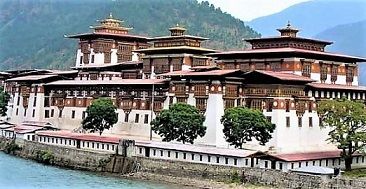- Home
- Bhutan Tour Packages
- About & Contact Us
- Bangalore To Bhutan Tour
- Mumbai To Bhutan Tour
- Kolkata to Bhutan Tour
- Delhi To Bhutan Tour
- Bhutan Tour By Land Road
- 5 Night 6 Days Tour
- 4 Night 5 Days Short Tour
- 6 Night 7 Days Tour
- 7 Night 8 Days Tour
- Paro Valley
- Thimpu The Capital
- Phuentsholing The Gateway
- Punakha District
- Tiger Nest Monastery Trek
- Festivals Of Bhutan
- Bumthang Valley
- Phobjikha Gangtey Valley
- Monument Museum Entry Fee
- Siliguri NJP Bhutan Tour
- Bhutan Visa Requirements
- SustainableDevelopmentFee
- Best time to Visit Bhutan
- Haa Valley

Punakha Valley- Sightseeing Distance From Paro/Thimpu
Punakha Valley is popular among tourist for its Punakha Dzong, amazing 17th-century fortress, its unique techniques for growing rice as well its beautiful architecture. Punakha is situated at the juncture of two beautiful rivers the Pho and Mo Chu rivers which makes this place look even more majestic.
About Punakha Valley
Punakha, once the capital of Bhutan until 1955, is a picturesque town located in the western part of the country. Nestled at the confluence of the Pho Chhu (Father River) and Mo Chhu (Mother River), Punakha boasts a blend of natural beauty, rich history, and vibrant cultural heritage. It is known for its fertile valley, warm climate, and significant role in Bhutanese history.
Punakha Dzong, also called the "Palace of Great Happiness," is one of the most iconic landmarks in Bhutan. Constructed in 1637 by Zhabdrung Ngawang Namgyal, the unifier of Bhutan, the dzong is not only a religious and administrative center but also a symbol of Bhutanese architecture and heritage.
The dzong holds special importance as it houses the sacred relics of the Drukpa Kagyu lineage and is the winter residence of Bhutan’s central monastic body, led by the Je Khenpo (Chief Abbot). The coronation of the first King of Bhutan, Ugyen Wangchuck, also took place here.
Punakha is a destination that offers a perfect blend of history, culture, and natural beauty. Its serene environment and iconic landmarks make it a must-visit location for anyone traveling to Bhutan. Whether you are exploring the grand Punakha Dzong, hiking through terraced fields, or soaking in the tranquility of the rivers, Punakha promises an unforgettable experience.

Sightseeing, Activities And Thinks to Do
Sightseeing Places
Punakha Dzong: One of Bhutan's most stunning architectural masterpieces, this fortress is situated at the confluence of the Pho Chhu and Mo Chhu rivers. It is renowned for its intricate woodwork, grand halls, and beautiful courtyards.
Suspension Bridge: Close to Punakha Dzong, this bridge is one of the longest suspension bridges in Bhutan. It provides breathtaking views of the rivers and is adorned with colorful prayer flags.
Chimi Lhakhang: Known as the "Temple of Fertility," this monastery is dedicated to Lama Drukpa Kunley, also known as the "Divine Madman." The temple is a pilgrimage site for couples seeking blessings for fertility.
Khamsum Yulley Namgyal Chorten: Located on a hill overlooking the Punakha Valley, this magnificent stupa was built to bring peace and harmony to the world. The trek to the chorten offers scenic views of the valley and surrounding rice paddies.
Pho Chhu and Mo Chhu Rivers: These rivers not only provide a tranquil ambiance but also offer opportunities for rafting and other water activities.
Activities | Things To Do
Trekking and Hiking: Punakha offers several trails that allow visitors to explore the surrounding hills and villages, such as the hike to Khamsum Yulley Namgyal Chorten.
River Rafting: The rivers in Punakha provide excellent opportunities for adventure sports, especially rafting.
Exploring Local Culture: Visitors can interact with locals, learn about their traditions, and experience the vibrant festivals, such as Punakha Drubchen and Punakha Tshechu.

Frequently Asked Questions
A: Punakha is well-connected to several major towns in Bhutan, and the distances between Punakha and these towns are as follows:
Thimphu to Punakha: Distance: Approximately 72 kilometers (45 miles).
Travel Time: About 2.5 to 3 hours by car.
Paro to Punakha: Distance: Approximately 125 kilometers (78 miles). Travel Time: Around 4 to 5 hours by car.
Bumthang (Jakar) to Punakha: Distance: Approximately 197 kilometers (122 miles). Travel Time: 7 to 8 hours by car.
Phuentsholing to Punakha: Distance: Approximately 182 kilometers (113 miles).
Travel Time: About 6 to 7 hours by car.
These travel times may vary based on road conditions, weather, and the pace of the journey. It’s advisable to check the latest updates on road conditions, especially during the monsoon or winter seasons.
A: Yes, additional permits are required to visit Punakha for international visitors and Indian tourists traveling to Bhutan. While the standard tourist visa allows travel to Paro and Thimphu, a separate permit is required to visit Punakha, Wangdue Phodrang, and other restricted areas. This permit can be arranged from the Immigration Office in Thimphu.
A: To visit Punakha and explore its key attractions, 1–2 days are typically sufficient for most travelers. However, the duration can vary depending on your interests and travel pace.
Suitable for those on a tight schedule or as part of a day trip from Thimphu.
Punakha Dzong, Suspension Bridge. Chimi Lhakhang are covered in a days tour.
Contact Us
Better yet, Call Us @ 24*7!
Message us on WhatsApp
Take A Break Travels & Holidays
H.O. 54 Ho Chi Minh Sarani, Kolkata700008, West Bengal, India.
Vatika Building, Link Road, Jaigaon Border(Near Immigration Office), Alipurduar, West Bengal 736182, India. 9830366923, 9038055530. tabkolkata@gmail.com
PUNAKHA VALLEY- SIGHTSEEING/DISTANCE

Tour De Bhutan
Powered by Vuvuta Digital Solutions
Copyright © 2026 Tour De Bhutan- Rights Reserved.
